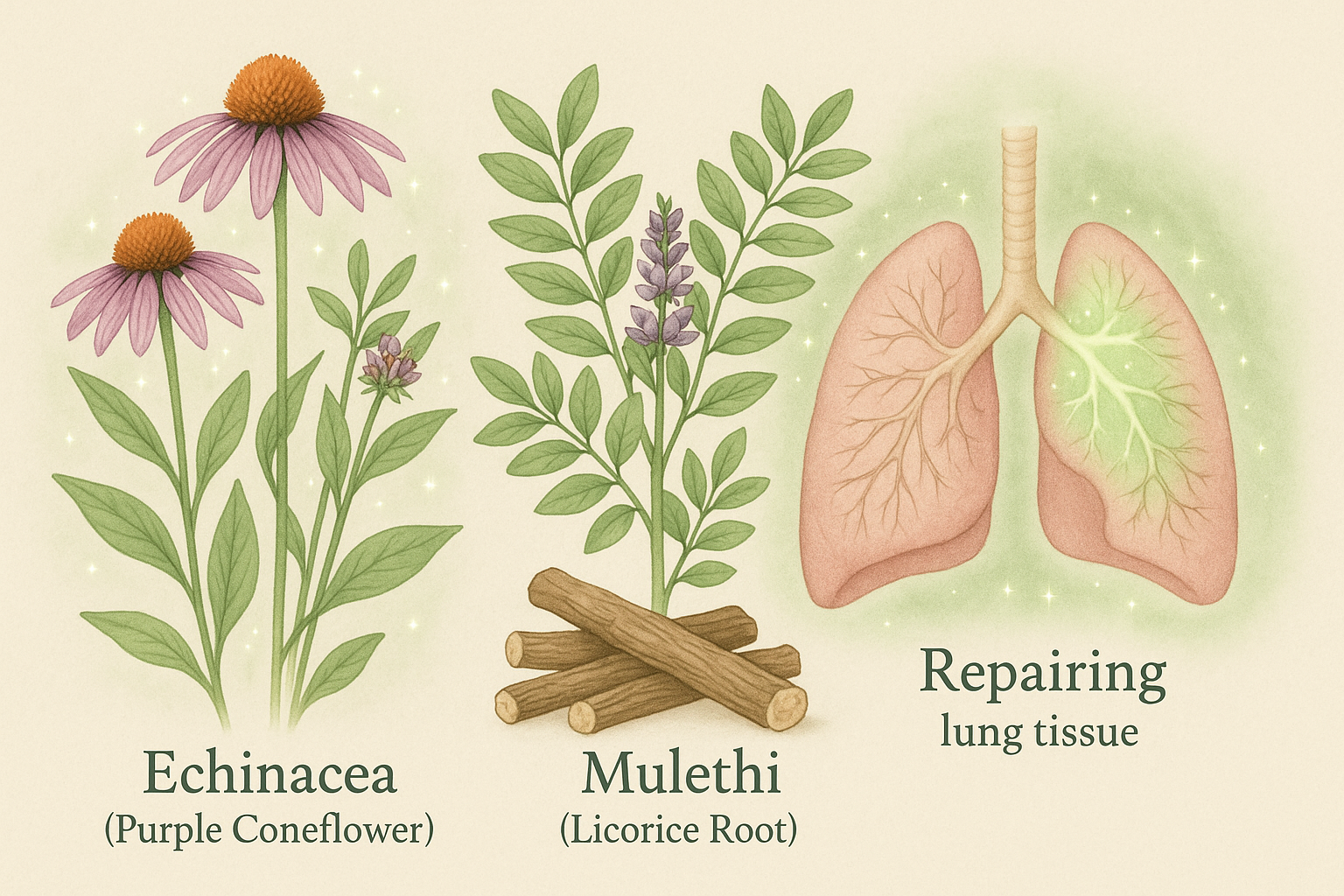
Can Echinacea and Mulethi Help Repair Lung Tissue? Here’s What Studies Say
The Growing Interest in Natural Lung Health Support
In an era marked by increasing respiratory challenges—from pollution and environmental toxins to viral infections and chronic lung conditions—the search for natural ways to support lung health has never been more relevant. Our lungs, those remarkable organs that facilitate the exchange of oxygen and carbon dioxide with every breath, are constantly exposed to irritants, pathogens, and inflammatory triggers that can compromise their function and integrity.
Two herbs have emerged prominently in discussions about natural respiratory support: Echinacea, a flowering plant native to North America with a long history in indigenous medicine, and Mulethi (also known as Licorice Root or Yashtimadhu), a cornerstone of Ayurvedic and traditional Chinese medicine for thousands of years. Both herbs have been traditionally used to address respiratory ailments, but the question remains: can they actually help repair lung tissue, and what does modern science say about their effectiveness?
This comprehensive exploration delves into the research, examining the mechanisms, clinical evidence, and practical applications of these two powerful botanical remedies for lung health and tissue repair.
Understanding Lung Tissue and the Need for Repair
Before examining how Echinacea and Mulethi might support lung health, it's important to understand what lung tissue repair entails. The lungs consist of delicate structures including alveoli (tiny air sacs where gas exchange occurs), bronchioles (small airways), and supportive connective tissue. These structures can become damaged through various mechanisms:
Inflammation: Chronic or acute inflammation can damage the delicate epithelial cells lining the airways and alveoli, leading to reduced lung function and increased susceptibility to infection.
Oxidative Stress: Free radicals generated by pollution, smoking, infections, and normal metabolic processes can damage cellular structures, including DNA, proteins, and lipid membranes in lung tissue.
Infections: Viral and bacterial respiratory infections can cause direct cellular damage and trigger inflammatory cascades that harm lung tissue.
Fibrosis: In some cases, damage leads to excessive scar tissue formation, which reduces lung elasticity and impairs gas exchange.
Environmental Exposures: Pollutants, allergens, and occupational exposures can cause cumulative damage to respiratory tissues over time.
The body possesses natural repair mechanisms, including the regeneration of epithelial cells and the resolution of inflammation. However, these processes can be impaired by chronic exposure to irritants, aging, nutritional deficiencies, or underlying health conditions. This is where supportive therapies, including herbal remedies, may play a valuable role.
Echinacea: The Immune-Modulating Powerhouse
Echinacea, primarily represented by three species—Echinacea purpurea, Echinacea angustifolia, and Echinacea pallida—has been used for centuries by Native American tribes for various ailments, particularly those affecting the respiratory system. Today, it ranks among the most extensively researched herbal remedies for immune support and respiratory health.
The Active Components
Echinacea contains a complex array of bioactive compounds that contribute to its therapeutic properties:
Alkylamides: These compounds have been shown to modulate immune function and possess anti-inflammatory properties by interacting with cannabinoid receptors.
Polysaccharides: Large sugar molecules that stimulate immune cell activity, particularly macrophages, which play crucial roles in clearing infections and damaged tissue.
Caffeic Acid Derivatives: Powerful antioxidants that protect cells from oxidative damage and possess antiviral properties.
Glycoproteins: Compounds that support immune function and may have direct antiviral effects.
What Studies Say About Echinacea and Respiratory Health
Research on Echinacea has focused primarily on its effects on respiratory infections, immune function, and inflammation—all factors relevant to lung tissue health and repair.
A comprehensive meta-analysis published in the journal Lancet Infectious Diseases examined multiple studies and found that Echinacea reduced the odds of developing the common cold by 58% and decreased the duration of colds by 1.4 days. While this doesn't directly prove lung tissue repair, preventing and shortening respiratory infections reduces the inflammatory burden on lung tissue, potentially preventing damage.
Research published in Phytomedicine demonstrated that Echinacea extracts possess significant anti-inflammatory properties by inhibiting the production of pro-inflammatory cytokines—signaling molecules that can cause tissue damage when overproduced. By modulating inflammation, Echinacea creates a more favorable environment for tissue repair.
A study in the Journal of Biomedicine and Biotechnology found that certain Echinacea preparations showed antiviral activity against respiratory viruses, including influenza and coronaviruses, by interfering with viral replication and entry into cells. Reducing viral load decreases direct viral damage to lung tissue and limits inflammation-induced secondary damage.
Regarding direct tissue repair mechanisms, research is more limited but promising. Studies have shown that Echinacea's polysaccharides can stimulate fibroblast activity—cells responsible for producing collagen and other structural proteins essential for tissue repair. Additionally, its antioxidant properties help protect cells from oxidative damage during the healing process.
Mulethi: The Ancient Respiratory Healer
Mulethi, known scientifically as Glycyrrhiza glabra, has been revered in traditional medicine systems worldwide for over 4,000 years. In Ayurvedic medicine, it's classified as a "Rasayana"—a rejuvenating herb that promotes longevity and vitality—with particular affinity for the respiratory system.
The Therapeutic Compounds in Mulethi
Mulethi's impressive therapeutic profile stems from its rich phytochemical composition:
Glycyrrhizin: The primary active compound, possessing potent anti-inflammatory, antiviral, and immune-modulating properties.
Flavonoids: Including liquiritin and isoliquiritin, which provide antioxidant and anti-inflammatory benefits.
Saponins: Compounds that have expectorant properties and support mucus clearance from airways.
Coumarins: Bioactive molecules with antimicrobial and anti-inflammatory effects.
Scientific Evidence for Mulethi's Lung-Supportive Properties
The scientific literature on Mulethi and respiratory health is extensive, with research spanning several decades.
A study published in Pulmonary Pharmacology & Therapeutics examined glycyrrhizin's effects on lung inflammation in animal models of acute respiratory distress syndrome (ARDS). The researchers found that glycyrrhizin significantly reduced inflammatory markers, decreased lung injury scores, and improved survival rates. The compound appeared to work by suppressing the activation of NF-κB, a key regulator of inflammatory responses.
Research in the Journal of Ethnopharmacology demonstrated that Mulethi extracts possess remarkable expectorant and mucolytic properties, helping to clear mucus and inflammatory debris from airways. This clearance is essential for lung tissue repair, as accumulated mucus can harbor pathogens and perpetuate inflammation.
A particularly relevant study published in Antiviral Research explored glycyrrhizin's effects on viral respiratory infections. The compound showed activity against multiple respiratory viruses by inhibiting viral replication and modulating immune responses to prevent excessive inflammation—a phenomenon known as "cytokine storm" that can cause severe lung tissue damage.
Regarding antioxidant effects, research in Food and Chemical Toxicology revealed that Mulethi's flavonoids provide robust protection against oxidative stress in lung tissue. In experimental models, these compounds reduced markers of lipid peroxidation and increased antioxidant enzyme activity, creating conditions more favorable for cellular repair and regeneration.
One of the most compelling aspects of Mulethi for lung tissue repair is its effect on fibrosis. Research published in Life Sciences showed that glycyrrhizin reduced pulmonary fibrosis in animal models by inhibiting the proliferation of lung fibroblasts and reducing collagen deposition. This suggests potential benefits for conditions involving excessive scar tissue formation in the lungs.
The Synergistic Potential: Combining Echinacea and Mulethi
While both herbs demonstrate individual benefits for respiratory health, their combination may offer synergistic advantages. This concept of herbal synergy—where the combined effect exceeds the sum of individual effects—is well-established in traditional medicine systems and increasingly supported by modern research.
Echinacea's strength lies primarily in immune modulation and antiviral activity, while Mulethi excels at reducing inflammation and supporting tissue repair. Together, they address multiple aspects of lung health:
Comprehensive Immune Support: Echinacea enhances immune surveillance and pathogen clearance, while Mulethi prevents excessive immune responses that cause collateral tissue damage.
Multi-Layered Anti-Inflammatory Action: Both herbs reduce inflammation through different mechanisms, potentially providing more complete inflammatory control than either alone.
Enhanced Antioxidant Protection: The combined antioxidant compounds from both herbs offer broader protection against oxidative stress.
Balanced Tissue Repair: While Mulethi promotes healing and prevents excessive fibrosis, Echinacea supports the cellular processes necessary for regeneration.
Beyond Repair: Additional Respiratory Benefits
While the focus of this article is lung tissue repair, both Echinacea and Mulethi offer additional respiratory benefits worth noting:
Reduced Infection Frequency: Regular use of these herbs, particularly during high-risk seasons, may decrease the frequency of respiratory infections, reducing cumulative lung tissue stress and damage.
Symptom Management: Both herbs have been shown to reduce the severity and duration of respiratory symptoms, improving quality of life during illness.
Support for Chronic Conditions: Preliminary research suggests potential benefits for individuals with chronic respiratory conditions like asthma, chronic bronchitis, and COPD, though more research is needed.
Enhanced Mucus Clearance: Mulethi's expectorant properties help maintain clear airways, reducing the risk of secondary infections and supporting optimal lung function.
Allergy Modulation: Both herbs possess antihistamine-like properties that may help manage allergic respiratory responses.
What the Research Doesn't Tell Us: Important Limitations
While the evidence for Echinacea and Mulethi supporting respiratory health is promising, it's crucial to acknowledge the limitations of current research:
Most direct tissue repair studies have been conducted in cell cultures or animal models, not human subjects. While these provide valuable insights into mechanisms, human clinical trials specifically examining lung tissue repair are limited.
Duration and dosage variations across studies make it difficult to establish optimal protocols for lung tissue repair specifically.
Individual response variability means that what works well for one person may be less effective for another, influenced by genetics, overall health status, and other factors.
Long-term safety and efficacy data, particularly for prolonged use focused on tissue repair rather than acute infection prevention, remain limited.
The severity of lung damage matters—these herbs are more likely to support natural repair processes in mild to moderate damage rather than reverse severe structural changes like advanced fibrosis or emphysema.
Practical Application: Using Echinacea and Mulethi for Lung Health
For those interested in incorporating these herbs into their respiratory wellness routine, here are evidence-based guidelines:
Dosing Considerations
Echinacea: Typical dosages range from 300-500mg of standardized extract three times daily, or 2-3ml of tincture three times daily. For acute respiratory infections, higher doses may be used short-term. For preventive and supportive use, moderate doses taken consistently are generally recommended.
Mulethi: Generally, 1-2 grams of dried root powder daily, or 400-600mg of standardized extract containing 20% glycyrrhizic acid. Due to potential side effects with prolonged high-dose use (discussed below), cycling or moderate continuous dosing is advisable.
Forms and Preparations
Both herbs are available in multiple forms:
- Capsules/Tablets: Convenient for precise dosing
- Tinctures/Liquid Extracts: Rapidly absorbed and easily customizable
- Teas: Gentler option, though potentially less concentrated
- Powders: Versatile for mixing into beverages or foods
Duration and Timing
For supporting recovery from respiratory illness, both herbs can be used throughout the illness and for several weeks afterward to support tissue repair. For preventive use, particularly during cold and flu season, intermittent use (such as 8 weeks on, 1-2 weeks off) may be beneficial.
Important Safety Considerations
Echinacea is generally well-tolerated, but individuals with autoimmune conditions should consult healthcare providers, as immune stimulation could theoretically exacerbate these conditions. Allergic reactions are possible, particularly in those allergic to plants in the Asteraceae family.
Mulethi requires more caution with extended use. Glycyrrhizin can cause pseudoaldosteronism—a condition characterized by high blood pressure, low potassium levels, and fluid retention—when used in high doses or for prolonged periods. Individuals with hypertension, kidney disease, heart conditions, or those taking certain medications (particularly diuretics, corticosteroids, or blood pressure medications) should avoid Mulethi or use it only under medical supervision.
Deglycyrrhizinated licorice (DGL) products, with glycyrrhizin removed, avoid these concerns but may have reduced anti-inflammatory effects relevant to lung tissue repair.
Complementary Approaches for Optimal Lung Health
While Echinacea and Mulethi show promise for supporting lung tissue health, they work best as part of a comprehensive approach:
Avoid Lung Irritants: Eliminate smoking, minimize exposure to air pollution, and use protective equipment when exposed to occupational lung hazards.
Optimize Nutrition: Ensure adequate intake of vitamins C, D, and E, along with minerals like zinc and selenium, which support immune function and tissue repair. Omega-3 fatty acids from fish or plant sources help resolve inflammation.
Stay Hydrated: Adequate hydration supports mucus clearance and optimal cellular function throughout the respiratory system.
Practice Breathing Exercises: Techniques like diaphragmatic breathing and pursed-lip breathing can improve lung capacity and efficiency.
Regular Physical Activity: Aerobic exercise strengthens respiratory muscles and improves overall lung function.
Address Underlying Conditions: Work with healthcare providers to manage conditions like asthma, allergies, or chronic bronchitis that contribute to ongoing lung tissue stress.
The Future of Herbal Lung Therapies
Research into plant-based respiratory therapies continues to expand. Emerging areas of investigation include:
- Identifying specific compounds within these herbs most responsible for tissue repair effects
- Developing standardized combinations optimized for different types of lung conditions
- Examining genetic factors that influence individual responses to herbal therapies
- Exploring the role of these herbs in supporting recovery from severe respiratory infections
- Investigating potential applications in chronic lung diseases
As our understanding deepens, we may see more targeted herbal preparations specifically designed to support lung tissue repair and regeneration.
Making Informed Decisions About Your Respiratory Health
The question of whether Echinacea and Mulethi can help repair lung tissue doesn't have a simple yes-or-no answer. The evidence suggests that both herbs possess properties that support the conditions necessary for lung tissue repair—reducing inflammation, combating oxidative stress, modulating immune responses, and in some cases directly influencing cellular repair processes.
However, "repair" is a complex biological process influenced by numerous factors. These herbs appear to support and optimize natural repair mechanisms rather than magically regenerating damaged tissue. For individuals with mild to moderate lung tissue stress from infections, environmental exposures, or inflammation, incorporating these herbs into a comprehensive wellness approach may provide meaningful benefits.
For those with serious lung conditions or significant tissue damage, these herbs should be viewed as complementary to, not replacements for, conventional medical care. Always work with qualified healthcare providers to develop an appropriate treatment plan for your specific situation.
Take Action for Your Respiratory Wellness
Supporting your lung health naturally requires a proactive approach. Whether you're recovering from a respiratory illness, managing chronic exposure to lung irritants, or simply seeking to optimize your respiratory wellness, herbal support can play a valuable role.
For those interested in exploring high-quality herbal supplements and natural wellness products to support overall vitality and health, visit https://matevara.com/collections/energy-booster to discover carefully curated formulations that combine traditional wisdom with modern quality standards.
Remember, your lungs work tirelessly every moment of every day. Giving them the support they need through evidence-based natural approaches, combined with healthy lifestyle choices, is an investment in your long-term health and quality of life.
Share








